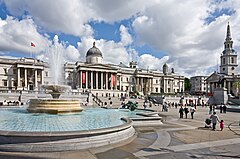
Back Trafalgarplein Afrikaans ميدان ترفلغار Arabic ميدان ترفلجار ARZ Trafalgar Square AST Trafalqar meydanı Azerbaijani Трафальгарская плошча Byelorussian Трафальгарская плошча BE-X-OLD Трафалгар (площад) Bulgarian ট্রাফালগার স্কয়ার Bengali/Bangla Trafalgar Square Breton
 View of the square in 2009 | |
| Former name(s) | Charing Cross |
|---|---|
| Namesake | Battle of Trafalgar |
| Maintained by | Greater London Authority |
| Location | City of Westminster, London, England |
| Postal code | WC2 |
| Coordinates | 51°30′29″N 00°07′41″W / 51.50806°N 0.12806°W |
| North | Charing Cross Road |
| East | The Strand |
| South | Northumberland Avenue Whitehall |
| West | The Mall |
| Construction | |
| Completion | c. 1840 |
| Other | |
| Designer | Sir Charles Barry |
| Website | www |
Trafalgar Square (/trəˈfælɡər/ trə-FAL-gər) is a public square in the City of Westminster, Central London, established in the early 19th century around the area formerly known as Charing Cross. The square's name commemorates the Battle of Trafalgar, the British naval victory in the Napoleonic Wars over France and Spain that took place on 21st October 1805 off the coast of Cape Trafalgar.
The site around Trafalgar Square has been a significant landmark since the 1200s. For centuries, distances measured from Charing Cross have served as location markers.[1] The site of the present square formerly contained the elaborately designed, enclosed courtyard, King's Mews. After George IV moved the mews to Buckingham Palace, the area was redeveloped by John Nash, but progress was slow after his death, and the square did not open until 1844. The 169-foot (52 m) Nelson's Column at its centre is guarded by four lion statues. A number of commemorative statues and sculptures occupy the square, but the Fourth Plinth, left empty since 1840, has been host to contemporary art since 1999. Prominent buildings facing the square include the National Gallery, St Martin-in-the-Fields, Canada House, and South Africa House.
The square has been used for community gatherings and political demonstrations, including Bloody Sunday in 1887, the culmination of the first Aldermaston March, anti-war protests, and campaigns against climate change. A Christmas tree has been donated to the square by Norway since 1947 and is erected for twelve days before and after Christmas Day. The square is a centre of annual celebrations on New Year's Eve. It was well known for its feral pigeons until their removal in the early 21st century.
- ^ "Where Is The Centre Of London?". BBC. 31 July 2008. Archived from the original on 17 August 2010. Retrieved 9 August 2020.
© MMXXIII Rich X Search. We shall prevail. All rights reserved. Rich X Search
